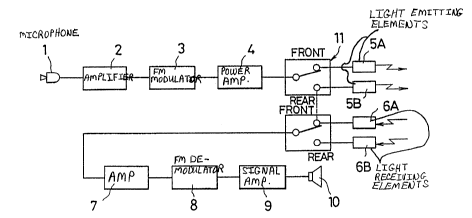Note: Descriptions are shown in the official language in which they were submitted.
- ~3~4~1
SPECIFICATIO~
O~tical Communication A~paratus for Motor Vehicle
Background to the Invention
(Field of the Invention)
The present invention relates to an optical communication
apparatus mounted on four-wheel motor vehicles for optical
communication among them.
(Prior Art)
If a plurality of persons move from one location to
another location, a plurality of motor vehicles are used. In
such a case, communication among them may be required
sometimes duriny such a trip, which communication should be
kept secret to third parties.
If a radio communication is used among motor vehicles,
there is a risk of leaking out the content of communication to
third parties, posiny a problem of leakage of secret.
Summary of the Invention
It ls therefore an object of the present invention to
~rovide an optical communication apuaratus for motor vehicles
capable of kee~ing secret during communication among theln.
According to an aspect of the present invention, an optical
communication a~aratus for motor vehicles comprises using a
light emittiny diode of a rear combination lamp, marker lamp
or the like as a light emitting element, providing a light
receiviny element near at the liyht emitting element, and
connectillg a transmitter to the light emitting element and a
receiver to the light receiving element.
Brief Description of the Drawings
` 1304784
The above and other objects and advantages of the present
invention will be described in more detail in the following,
by way of example, reference being made to the accompanying
drawinys, in which:
Fig.1 is a block diagram showing an embodiment of an
optical communication apparatus for a motor vehicle accordiny
to the present invention;
Fig.2 is a side elevational view illustrating how optical
communication is performed among motor vehicles; and
Figs.3 and 4 show the mounting condition of the light
emitting and receiving elements of the embodiment.
Detailed Description of the Preferred Embodiment
An embodiment of this invention will be described in
detail with reference to the accompanying drawings.
Figs.1 to 4 show an embodiment of the optical
communication apparatus for a motor vehicle according to the
present invention. Referring to the figures, reference numeral
1 represents a ~icrophone, 2 an amplifier for amplifying a
voice or audio siynal, 3 an FM modulator for FM modulating the
voice signal, 4 a power amplifier, and 5A and 5B a light
emitting element driven by an output from the amplifier 4. If
a rear combination lamp (refer to Fig.3) and front marker
lamp (refer to Fig.4) are constructed of light emitting diodes
(LEDsj, then LEDs are used as the light emitting
elements.
6A and 6B represent light receiving elements such as
photodiodes, 7 an amplifier for amplifying received siynal, 8
~304784
an FM demodulator for FM demodulating an output from the
amplifier, 9 a voice or audio signal amplifier for amplifyiny
a voice signal, and 10 a loudspeaker. The light receiving
elements 6A and 6B are mounted near at the rear combination
lamp (shown in Fig.3) and marker lamp (shown in Fig.4).
The rear, and front light emitting elements 5A and 5B,
and the light receiving elements 6A and 6B are interchanyeably
switched by using a switch 11, respectively.
In operation, for example, for communication between
motor vehicles A and B as shown in Fig.2, light pulses of a
carrier frequency fa modulated by voice is emitted out from
the light emitting element 5B of the motor vehicle ~ to the
motor vehicle B. The light pulses are received by the liyht
receiving element mounted at the front of the motor vehicle B,
amplified, FM modulated, audio-amplified, and supplied to the
loudspeaker 10 to yenerate voices.
On the contrary, light pulses of a carrier frequency fb
are emitted out from the motor vehicle s to the motor vehicle
A. The light pulses are received by the light receiving
element mounted at the rear of the motor vehicle A, amplified,
FM demodulated, audio-amplified, and supplied to the
loudspeaker 10 to yenerate voices.
Unless optical communication is not performed in full
duplex manner, a same carrier frequel1cy can be used in sending
and receiving light pulses.
As appreciated from the foreyoing description of the
present invention, although a service area is limited because
of optical communication, cross talk can be reduced. Further,
1304784
as the light emitting element, the LEDs of the rear
combination lamp and marker lamp can be used so that no
additional light emitting element for such particular function
is not used, resulting in low cost. In addition, by using
different carrier frequencies in sending and receiving light
yulses, optical communication can be realized simultaneously
among motor vehicles.
Although the present invention has been described in
connection with the preferred embodiment thereof with
reference to the accompanying drawings, it will be apparent to
those skilled in the art that various changes and
modifications of the present invention are possible within the
scope of the following claim.
